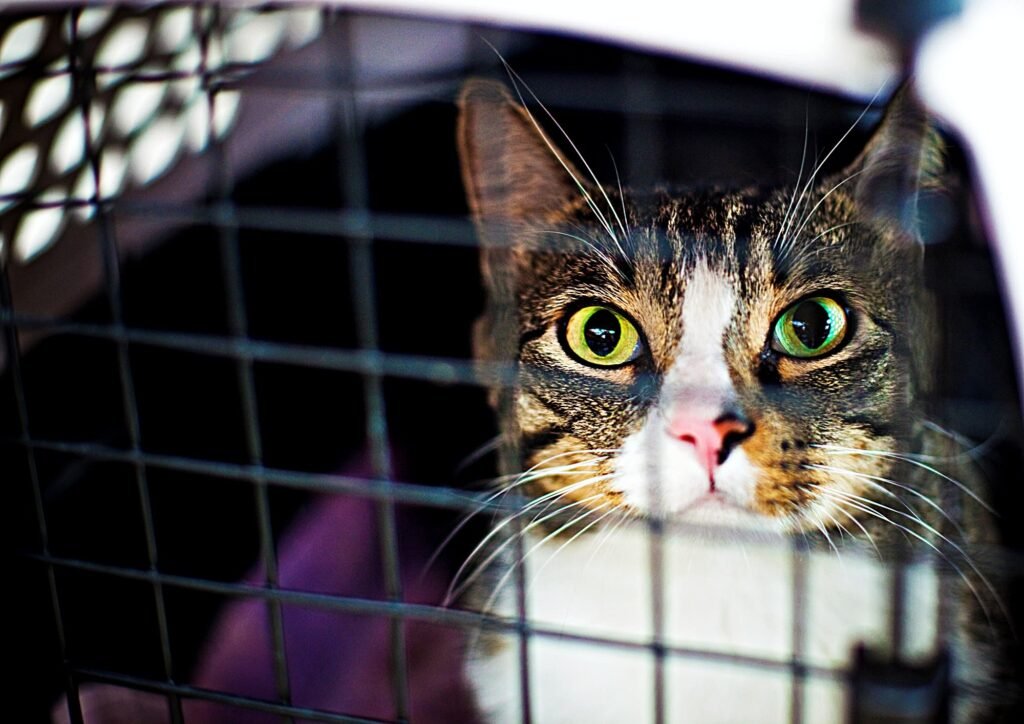Quick Preparation Guide Before Leaving Home
Leaving an outdoor cat behind while travelling requires careful planning. Here’s a quick checklist to start with:
● Arrange for a trusted person to check on your cat daily.
● Ensure the garden and boundaries are secure.
● Remove or lock away any tools, chemicals, or hazards.
● Provide multiple water and feeding stations.
● Prepare sheltered spaces for different weather conditions.
● Double-check escape prevention measures.
Why Travel Poses Unique Risks for Outdoor Cats
Travelling means you can’t monitor your cat’s behaviour in real-time. While cats are generally independent, outdoor environments carry risks that can escalate quickly if no one is there to respond. A toppled water bowl on a hot day, a damaged fence panel, or an unexpected wildlife encounter can all become serious threats without immediate attention.
When owners are away, cats may also change their routines. Some become more adventurous and attempt to roam further, while others may become stressed and hide more frequently. Understanding these behavioural shifts is key to preparing a safe environment before you go.
Choosing the Right Care Option While You’re Away
There are three main options for cat care during travel: having someone stay in your home, arranging daily visits, or relocating your cat temporarily. Each has pros and cons.
In-home sitters provide continuity, keeping your cat in their familiar environment. This is especially helpful for outdoor cats who know the layout of their territory.
Daily visits are more affordable, but the cat spends more time alone. For outdoor cats, this can mean longer periods without supervision.
Temporary relocation (to a friend’s home or boarding facility) ensures constant care but can be stressful if the cat loses access to its known territory.
For cats accustomed to outdoor time, the best solution often involves maintaining their routine but with reinforced safety measures.
Securing the Garden Before Departure
Before leaving, check every part of your garden for vulnerabilities. Weather, wildlife, and even determined digging can create new escape routes.
Installing a cat fence barrier adds a reliable layer of protection, ensuring that even if your cat attempts to climb the fence while you’re away, they won’t succeed.
Other tasks before travel include:
● Trimming branches that overhang the fence.
● Moving bins, tables, or other climbable objects away from boundaries.
● Filling gaps under fences where animals could pass through.
● Ensuring gates are securely locked and in good condition.
Preparing Shelter and Resources
Since you won’t be there to let your cat inside during bad weather, outdoor shelters are essential. These should be waterproof, insulated, and raised off the ground to prevent dampness.
Water is just as important — and it should be placed in multiple locations. Even if one bowl is knocked over or contaminated, the others ensure hydration. Using weighted or spill-proof bowls can help.
Food stations should also be placed in sheltered areas to prevent spoilage. If your sitter cannot feed the cat at the same time every day, an automatic feeder can help maintain a routine.
Enrichment While You’re Away
Cats can become bored if their outdoor environment doesn’t change. Boredom can lead to stress behaviours like overgrooming or increased attempts to escape.
Add variety before you leave:
● Hide small treats or kibble in safe spots for your cat to discover.
● Rotate toys or add new weatherproof ones.
● Create lookout points where your cat can observe the surroundings without roaming.
Even small changes can keep your cat mentally stimulated while you’re gone.
Communication With Your Cat Sitter
A clear set of instructions is vital. Outline your cat’s routines, favourite hiding spots, and any areas that should remain off-limits. Provide details on how to check and maintain boundary security.
It’s a good idea to show your sitter how to inspect the cat fence outdoor system, gates, and shelter areas. If any issues arise, they’ll know exactly how to address them.
If possible, arrange for the sitter to visit once or twice before your trip so your cat can get used to them. This makes the transition smoother and reduces stress for both the cat and the carer.
Handling Emergencies From Afar
Even with careful preparation, emergencies can happen. Have a plan for vet visits, including:
● The location of your cat’s carrier.
● Contact details for your regular vet and the nearest emergency clinic.
● Your written consent for the sitter to authorise treatment in your absence.
Also, consider leaving a backup key with a neighbour or friend in case your sitter is delayed or unavailable.
Returning Home and Readjusting
When you return, your cat may be extra clingy, aloof, or slightly unsettled. Spend time in the garden with them to re-establish your presence in their outdoor routine. Check the perimeter for any changes that might have occurred while you were away.
If your sitter has noted any escape attempts, consider making additional modifications before your next trip. Travelling cat owners benefit from keeping a running list of improvements after each time away.
Conclusion
Travelling while leaving an outdoor cat at home requires a balance of preparation, secure boundaries, and reliable human support. By securing your garden, providing resources, and ensuring daily check-ins, you can reduce risks and maintain your cat’s wellbeing in your absence.
The key is to think ahead, prepare for multiple scenarios, and maintain your cat’s familiar environment as much as possible. With the right setup, your cat can remain safe, comfortable, and content until you’re back.


